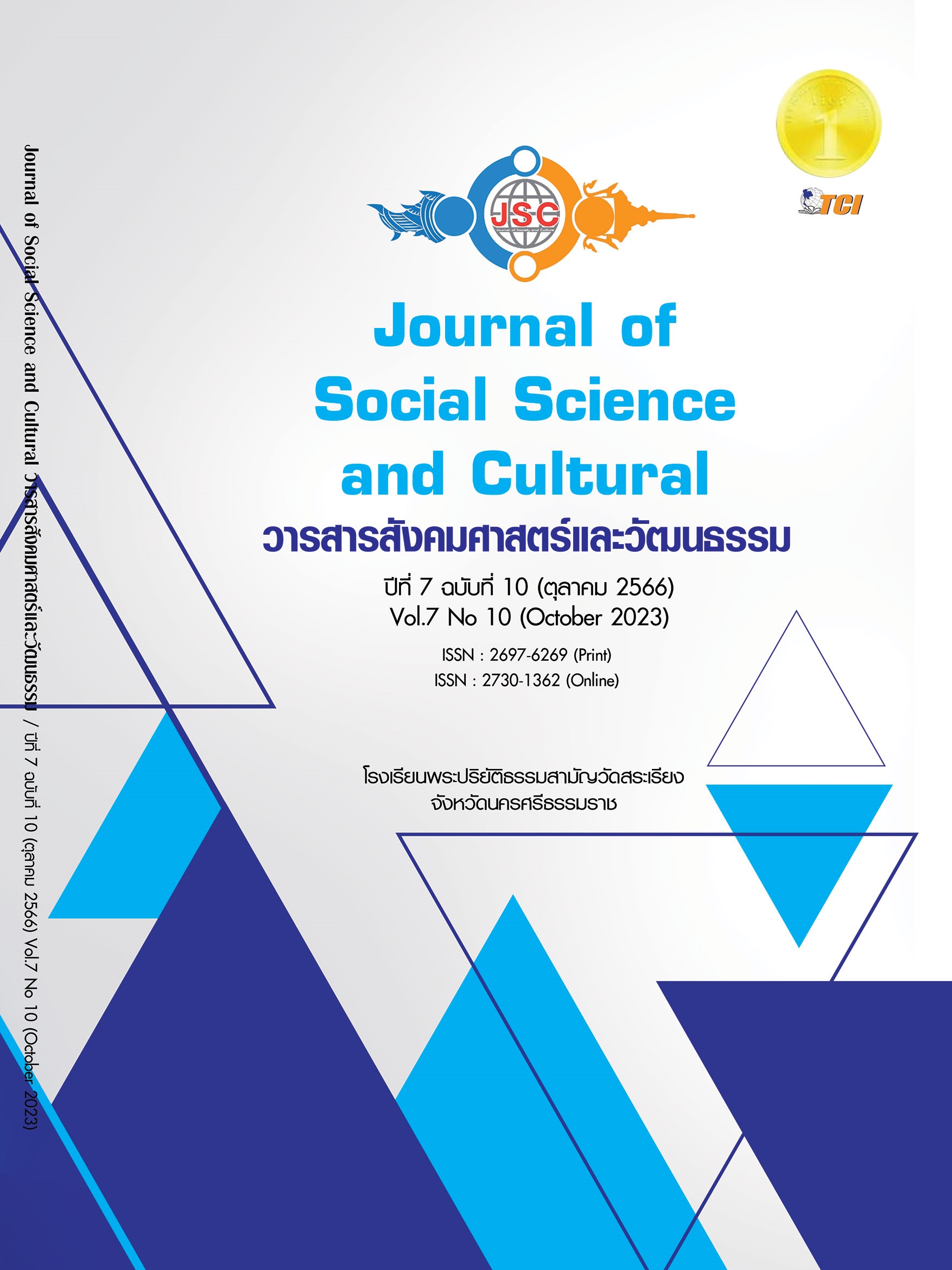ANALYSIS COMPONENTS OF CREATIVE PROBLEM SOLVING COMPETENCY OF UPPER PRIMARY SCHOOL STUDENTS THAILAND
Main Article Content
Abstract
The purpose of this research article is to analyze the components and behaviors indicating creative problem-solving competencies of upper primary school students across the country. Using a mixed methods research method, the research method consists of 2 steps as follows: 1. Create inductive conclusions by synthesizing the definition and components of creative problem-solving competencies of upper primary school students. From research documents in the period 2017 - 2022 2. Create conclusions confirming the elements and behaviors indicating creative problem-solving competencies of upper primary school students. By means of focus group discussions with 2 groups of experts, those who received national or international innovation awards and the upper primary school student advisors who received national or international innovation awards, a total of 10 persons, and analyze content data and document analysis. The research results found that the competencies Creative problem solving for upper primary school students consists of 3 elements: 1. Seeking a conclusion to the real problem. Consists of behavior of observing problems, asking questions, and striving to solve problems. Use technology to search for information Can collect information Check the reliability of the information Able to analyze problems Order of importance of problems Identify the real problem Analyze the causes of problems and identify the causes of problems. 2. Creating a creative problem solving model includes behavior and analyzing the elements of a complete problem solving model. Generate new problem solving ideas Evaluate the pros and cons of the solution. Able to identify ideas according to one's own imagination and analyze many ways to solve problems. 3 Systematic problem solving includes problem-solving planning behavior. Solve problems as planned Test the method that solves the problem. Evaluate the appropriateness of the solution. Improve the method to solve problems appropriately. Complete problems on time and solve problems together with friends.
Article Details
References
กรภัสสร อินทรบำรุง. (2563). ความคิดสร้างสรรค์ : ส่งเสริมอย่างไรในวัยอนุบาล. วารสารศึกษาศาสตร์ มหาวิทยาลัยศิลปากร, 18(1), 9-30.
ชุติวัฒน์ สุวัตถิพงศ์. (2562). การพัฒนามนุษย์ด้านการศึกษาในบริบทโลก (เอกสารประกอบการสอน). นนทบุรี: มหาวิทยาลัยสุโขทัยธรรมาธิราช.
ฐิญาณา สุภัทรชยาภูมิ. (2563). รูปแบบการเรียนรู้โครงงานที่เน้นจิตสังคมเพื่อส่งเสริมพฤติกรรมแก้ปัญหาอย่างสร้างสรรค์สำหรับนักเรียนชั้นประถมศึกษาปีที่ 6. วารสารพฤติกรรมศาสตร์เพื่อการพัฒนา, 12(1), 92-115.
นงนุช เอกตระกูล. (2561). การพัฒนาโปรแกรมเพิ่มพูนประสบการณ์ทางวิทยาศาสตร์ที่ส่งเสริมความสามารถในการแก้ปัญหาอย่างสร้างสรรค์และความสุขในการเรียนของนักเรียนชั้นประถมศึกษาตอนปลาย. วารสารวิจัยและพัฒนาหลักสูตร, 8(2), 129-142.
ปรัชฌภรณ์ ทวีสุข. (2561). การพัฒนากิจกรรมพัฒนาผู้เรียน โดยใช้กิจกรรมเป็นฐานร่วมกับกระบวนการแก้ปัญหาอย่างสร้างสรรค์เพื่อส่งเสริมทักษะการแก้ปัญหาอย่างสร้างสรรค์สำหรับนักเรียนชั้นมัธยมศึกษาปีที่ 4-6. ใน วิทยานิพนธ์ศึกษาศาสตรมหาบัณฑิต สาขาวิชาหลักสูตรและการนิเทศ. มหาวิทยาลัยศิลปากร.
พรสวรรค์ วงค์ตาธรรม. (2558). การคิดแก้ปัญหาเชิงสร้างสรรค์ ทักษะการคิดในศตวรรษที่ 21. วารสารศึกษาศาสตร์ มหาวิทยาลัยขอนแก่น, 38(2), 111-121.
ภัทรี สุรโรจน์ประจักษ์. (2561). การพัฒนากระบวนการแก้ปัญหาตามแนวคิดการเรียนรู้โดยใช้ความ ท้าทายป็นฐานผสมผสานแนวคิดการวางแผนกลยุทธ์เพื่อส่งเสริมความสามารถในการแก้ปัญหาอย่างสร้างสรรค์ของนักเรียนชั้นประถมศึกษา. วารสารครุศาสตร์ จุฬาลงกรณ์มหาวิทยาลัย, 46(2), 157-179.
สถาบันทดสอบทางการศึกษาแห่งชาติ. (2563). การพัฒนาระบบการทดสอบสมรรถนะหลักของผู้เรียนระดับประถมศึกษาตอนต้นเพื่อส่งเสริมการยกระดับคุณภาพผู้เรียนในศตวรรษที่ 21. กรุงเทพมหานคร: สถาบันทดสอบทางการศึกษาแห่งชาติ.
สำนักงานเลขาธิการสภาการศึกษา กระทรวงศึกษาธิการ. (2562). เข้าใจสมรรถนะอย่างง่ายๆ ฉบับประชาชน และเข้าใจหลักสูตรฐานสมรรถนะอย่างง่ายๆ ฉบับครู ผู้บริหาร และบุคลากรทางการศึกษา. กรุงเทพมหานคร: กลุ่มมาตรฐานการศึกษา สำนักมาตรฐานการศึกษาและพัฒนาการเรียนรู้ สำนักงานเลขาธิการสภาการศึกษา.
อารยา แก้วบัวดี. (2562). การพัฒนาผลสัมฤทธิ์ทางการเรียนและความสามารถในการคิดแก้ปัญหาอย่างสร้างสรรค์ โดยใช้การจัดการเรียนรู้วิทยาศาสตร์ตามแนวสะเต็มศึกษาของนักเรียนชั้นประถมศึกษาปีที่ 5. วารสารสังคมศาสตร์วิจัย, 10(2), 130-148.
อารีวรรณ ทองสุ. (2562). สภาพการจััดการเรีียนรู้้วิิชาวิิทยาศาสตร์ที่ส่่งเสริิมทัักษะการแก้ปัญหาอย่่างสร้างสรรค์์สำหรัับนัักเรีียนชั้นประถมศึึกษาปีีที่ 4. วารสารมหาวิทยาลัยศิลปากร, 39(2), 175-186.


